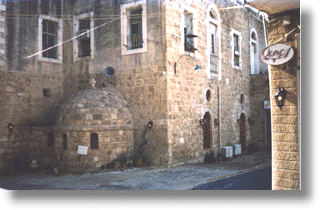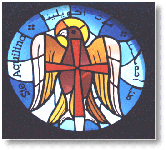Part III By Micheline Atallah This last of a three-part account of Saint Aquilina focuses upon her ancient sanctuary and her new Church in Byblos. Part I, in the Journal of Maronite Studies (JMS), Vol. 3, Issue 2, April 1999, described her passion and martyrdom, and for the first time made available the sacred canon or hymn of Saint Joseph the Hymnographer. Part II, in the JMS, Vol. 3, Issue 3, July 1999, described her icons, today's devotion to her, and recent wonders or miraculous events associated with her. Special acknowledgment is due Mr. Shehadeh Boutros Al 'Etayek and Mr. Boutros Elias Zgheib and his family for their assistance in research, and Mr. Samir Nasr for the photography. Introduction
The exact sites where Aquilina, Martyr of Byblos lived, died, was buried, and revered are speculative because documentation is scarce. Some researchers like Father Henry Lammens believe that the sacred site of Our Lady of Martine in the southern area of Byblos is the martyrium of Saint Aquilina. He has written that the faithful would take sand -- like a sacramental -- from there during the silk season in June, the month in which the feast day of Saint Aquilina falls. By this, Lammens may be indicating a connection between that holy site and the location of her martyrdom. (Lammens 1982: Vol. 1, 105) There is, however, a small, ancient sanctuary dedicated to Saint Aquilina in the Kassouba or commonly known Zgheib Clan quarter. Researchers believe that this sanctuary could have been Aquilina's tomb. This opinion has a basis in her martyrology which places Aquilina's grave outside the city boundaries. According to French scholar Ernest Renan, the sanctum or sacred site of Our Lady of Martine falls within the necropolis of the old city. When excavating in Byblos, Renan found next to this sacred site several mausoleums with engravings that indicate the exalted status of their owners. Among the tombs are those of Serapion, Professor of the Ephebe, and his wife Dionysia. Renan believes that this site was the official cemetery of the city during the Roman era, and that it was unlikely to contain Christians because they were ostracized, even in death, from elite pagan society in Aquilina's time. (Renan 1864: 183-185) Aquilina is probably buried at her sanctuary in Kassouba, outside the boundaries of the old city. More excavations and serious study are needed to obtain more precise or definite information.
The lack of documentary evidence limits us to describing the present state of Aquilina's surviving monuments: the sanctuary in Kassouba and the new church in the Byblos old market (souk). The church, in the neighborhood of the ancient citadel, occupies the ground floor of an old two-story building. The ground floor has served many purposes and was once a women's prison. The building was bought to house Saint Aquilina's new church because the people of Byblos believe that after her execution, her body was thrown in the street recently named after her. Construction of the church by the Lebanese Maronite Order of monks and the townspeople was completed in 1996.
The white coating covering the inside walls was removed to reveal the splendid natural stone. Though not originally conceived by the architect to be a church, the planning of a 100 square meter rectangle reminds us of the ancient, small Maronite churches of a single nave in the Lebanese villages. In the plan, there is the apse and the nave. It is the design of the latter -- the single nave church or the chapel -- that goes back to the twelfth and thirteenth centuries (Moukarzel 1992: 379). The rectangular shape is plain and simple; the apse is in the form of a cul-de-four, a concave half dome. The altar, in the form of a rectangular monolith (huge stone), is in the center of the foyer. The plan includes a border of natural stone walls which result in a series of three crossed vaults. It mirrors the simplicity and austerity of an ancient Maronite church. The exterior consists of rough-edged stone which again produce an austere look. The interior holds all the mystery of a cavern (Moukarzel 1992: 379). The cross-vaults give the feeling of spaciousness. Though the interior is made of bare cold stone, there is the feeling of warmth. When light penetrates the apse and the dim nave, the rays strike the stone and the church has an otherworldly atmosphere. Completing the design of the church is the concave semi-dome apse at one end of the rectangle in the longitudinal extension of the series of vaults. Traditionally, at the top of the apse, a small aperture has been carved out and that is the only source of [natural] light in Maronite churches. This sole source of sunlight in the somber space is impressive. (Moukarzel 1992: 380). French.
The architectural composition, inspired by old Lebanese churches, is pleasing. Even if we delineate very clearly the addition, i.e. the apse, there is unity between that and the nave. The building is enhanced by the stained glass which imparts an "old fashioned look." The main door is of carved wood and above it in stained glass is the eagle, Aquilina's symbol. The words, "Saint Aquilina", are inscribed in the glass in three languages: Syriac, Arabic and The new church resembles an ancient one. Thoughtful planning and excellent craftsmanship are evident, the efforts made in this design succeeded in forming an organic whole between the nave and the apse. The Sanctuary In the collective memory of the people of Byblos, this small sanctuary of 20 square meters has always been called "Saidet Aquilina" or Saint Aquilina. It falls within Saint George's Parish in the Zgheib quarter. All of it was in ruins until Boutros Elias Zgheib and his family renovated it in 1988. (Zgheib Al-Jubaili 1993: 5) The work was done as an act of love and in recognition of the young saint. The sanctuary was consecrated on Aquilina's feast day in the Maronite calendar, June 13, 1990.
The workmen restored the half-destroyed sanctuary, including walls and sections of the apse and dome. Measurements and size were based upon what remained of the ruins. There is no historical correlation between the present dimensions and the ancient, original ones. Nevertheless, the results are agreeable. Huge stones recovered from nearby and from the site of the original sanctuary were used in the reconstruction. Their size and irregularity indicate the antiquity of the original temple or structure. (Moukarzel 1992: 378) Conclusion The church and the sanctuary are the only two edifices in honor of Saint
Aquilina in Lebanon. In the effort to preserve part of the Maronite heritage,
both sites incorporated most of the distinctive characteristics of Maronite
architecture. Both places are physical proof of the renewed veneration
of Saint Aquilina, 17 centuries after her martyrdom.
Bibliography Lammens, H. Tasrih Al-Absar fi ma Yahtawi Lubnan min al-Athar. (In Arabic), 2 Vols. Beirut, 1982. Moukarzel, A. Architecture Maronite, Encyclopédie Maronite, USEK: Kaslik, Lebanon , 1992, pp. 376-388. Ragette, F. Architecture in Lebanon. Caravan Books: New York, 1980. Renan, E. Mission de Phénicie. (In French), Paris, 1864. Zgheib Al-Jubaili, A. Al Qedissat al Shahida Al Jubeyliat Aquilina.
(In Arabic), Byblos, 1993.
|




